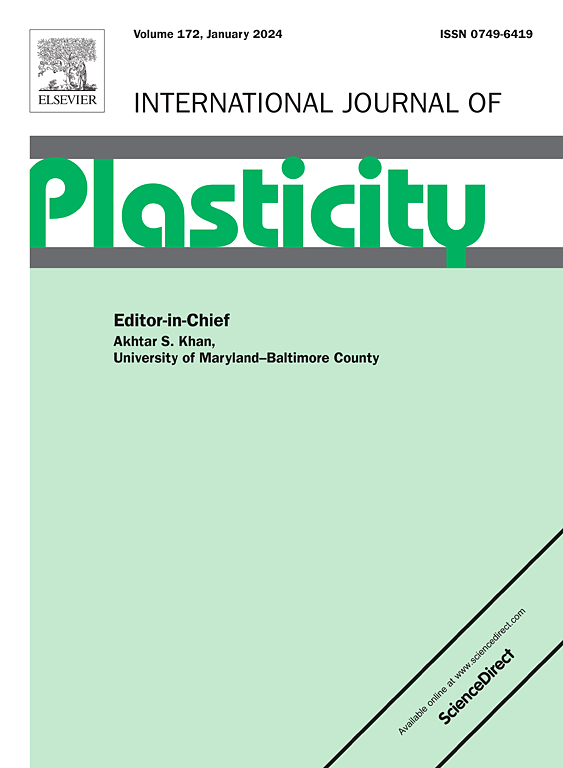Mitigating creep anisotropy of largely pre-deformed Al-Cu alloys by shape tailoring of dislocation sub-structures
IF 9.4
1区 材料科学
Q1 ENGINEERING, MECHANICAL
引用次数: 0
Abstract
Introducing high-density dislocations by large pre-deformation could afford a significant increase in both the creep formability and mechanical properties of aluminum alloys. However, the strong creep anisotropy typical of the alloy sheets prepared by this method, e.g. cold-rolling with a large thickness reduction, leads to the difficulty in accurate creep age forming of doubly curved panels. Clarifying the influence of different types of microstructures on the creep deformation is pivotal in tailoring the creep anisotropy of largely pre-deformed Al alloys. This study investigated the creep aging responses of largely pre-deformed Al-Cu alloys prepared using two different processes, i.e. unidirectional rolling and cross-rolling, with a same total thickness reduction of 80 %. Cross-rolling was applied by changing the rolling direction by 90° about normal direction in the second step. The in-plane creep anisotropy index of the sample prepared through the 3:1 (ratio of the reductions in two steps) cross-rolling scheme is about 13 %, much lower than that (about 49 %) of the unidirectional rolling sample. The as-rolled and creep-aged samples for unidirectional rolling, 1:1 and 3:1 cross-rolling exhibited similar tensile properties and had a yield strength anisotropy index less than 6 %. Detailed characterizations by electron back-scattering diffraction (EBSD) and scanning transmission electron microscopy (STEM) reveal that cross-rolling mainly changes the dislocation substructures rather than the grain orientations and precipitates in the largely pre-deformed alloys. The dislocation cells with a diameter ranging from 400 nm to 1.8 μm changed from the "elliptical" shape in the unidirectional rolling sample to a "circular" shape in the 3:1 cross rolling sample. The crystal plasticity finite element models considering the effect of dislocation substructures were established to simulate the creep deformation in the largely pre-deformed Al alloys. Multi-scale experimental characterizations and crystal plasticity finite element simulations demonstrate that the texture and grain shape have little influence while the dislocation substructure plays a dominant role in the creep anisotropy in the largely pre-deformed Al-Cu alloys. Our findings inspire alleviating creep anisotropy of largely pre-deformed Al alloys by shape tailoring of dislocation sub-structures.


通过位错子结构的形状剪裁来减轻预变形Al-Cu合金的蠕变各向异性
通过大的预变形引入高密度位错可以显著提高铝合金的蠕变成形性能和力学性能。然而,这种方法制备的合金板具有很强的蠕变各向异性,例如冷轧减薄量大,导致双弯曲板的精确蠕变时效成形困难。弄清不同类型的组织对蠕变变形的影响是确定预变形铝合金蠕变各向异性的关键。研究了单向轧制和交叉轧制两种不同工艺制备的预变形Al-Cu合金的蠕变时效响应。在第二步中,通过将轧制方向在法向上改变90°进行交叉轧制。通过3:1(两步还原比)横轧方案制备的试样的面内蠕变各向异性指数约为13%,远低于单向轧制试样的面内蠕变各向异性指数约为49%。单向轧制、1:1和3:1交叉轧制的轧制态和蠕变时效试样的拉伸性能相似,屈服强度各向异性指数均小于6%。通过电子背散射衍射(EBSD)和扫描透射电镜(STEM)的详细表征表明,在预变形较大的合金中,交叉轧制主要改变了位错亚结构,而不是晶粒取向和析出物。直径在400 nm ~ 1.8 μm范围内的位错胞由单向轧制时的“椭圆形”变为3:1交叉轧制时的“圆形”。建立了考虑位错子结构影响的晶体塑性有限元模型,模拟了预变形铝合金的蠕变过程。多尺度实验表征和晶体塑性有限元模拟表明,在预变形较大的Al-Cu合金中,织构和晶粒形状对其蠕变各向异性的影响较小,而位错亚结构对其蠕变各向异性起主导作用。我们的发现启发了通过位错子结构的形状剪裁来减轻预变形铝合金的蠕变各向异性。
本文章由计算机程序翻译,如有差异,请以英文原文为准。
求助全文
约1分钟内获得全文
求助全文
来源期刊

International Journal of Plasticity
工程技术-材料科学:综合
CiteScore
15.30
自引率
26.50%
发文量
256
审稿时长
46 days
期刊介绍:
International Journal of Plasticity aims to present original research encompassing all facets of plastic deformation, damage, and fracture behavior in both isotropic and anisotropic solids. This includes exploring the thermodynamics of plasticity and fracture, continuum theory, and macroscopic as well as microscopic phenomena.
Topics of interest span the plastic behavior of single crystals and polycrystalline metals, ceramics, rocks, soils, composites, nanocrystalline and microelectronics materials, shape memory alloys, ferroelectric ceramics, thin films, and polymers. Additionally, the journal covers plasticity aspects of failure and fracture mechanics. Contributions involving significant experimental, numerical, or theoretical advancements that enhance the understanding of the plastic behavior of solids are particularly valued. Papers addressing the modeling of finite nonlinear elastic deformation, bearing similarities to the modeling of plastic deformation, are also welcomed.
 求助内容:
求助内容: 应助结果提醒方式:
应助结果提醒方式:


